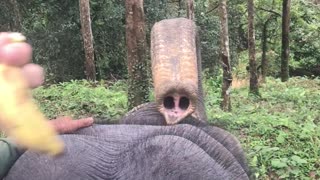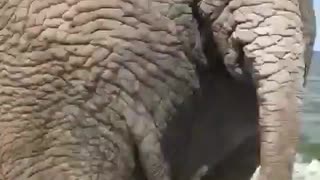Premium Only Content

elephant toothpaste - simple live for an elephant - kinds of elephants
#animals
#elephant
#elephantdeath
Elephants are mammals of the mammal family and therefore the largest existing land animals. Three species are currently recognised: the African bush elephant, the African forest elephant, and therefore the Asian elephant. Elephantidae is that the only surviving family of the order Proboscidea; extinct members include the mastodons. The family Elephantidae also contains several now-extinct groups, including the mammoths and straight-tusked elephants. African elephants have larger ears and concave backs, whereas Asian elephants have smaller ears, and convex or level backs. Distinctive features of all elephants include a protracted trunk, tusks, large ear flaps, massive legs, and hard but sensitive skin. The trunk, also called a proboscis, is employed for breathing, bringing food and water to the mouth, and grasping objects. Tusks, which are derived from the incisor teeth, serve both as weapons and as tools for moving objects and digging. the big ear flaps assist in maintaining a relentless vital sign still as in communication. The pillar-like legs carry their great weight. Elephants are scattered throughout geographical region, South Asia, and geographic area and are found in numerous habitats, including savannahs, forests, deserts, and marshes. they're herbivorous, and that they stay near water when it's accessible. they're considered to be keystone species, thanks to their impact on their environments. Other animals tend to stay their distance from elephants; the exception is their predators like lions, tigers, hyenas, and wild dogs, which usually target only young elephants (calves). Elephants have a fission–fusion society, within which multiple family groups close to socialize. Females (cows) tend to measure in family groups, which might contains one female along with her calves or several related females with offspring. The groups, which don't include bulls, are led by the (usually) oldest cow, referred to as the matriarch. Males (bulls) leave their family groups after they reach puberty, and will live alone or with other males. Adult bulls mostly interact with family groups when trying to find a mate. They enter a state of increased testosterone and aggression called musth, which helps them gain dominance over other males moreover as reproductive success. Calves are the centre of attention in their family groups and depend upon their mothers for as long as three years. Elephants can live up to 70 years within the wild. they impart by touch, sight, smell, and sound; elephants use infrasound, and seismic communication over long distances. Elephant intelligence has been compared thereupon of primates and cetaceans. they seem to own self-awareness, also as appearing to point out empathy for dying and dead relations. African elephants are listed as vulnerable and Asian elephants as endangered by the International Union for Conservation of Nature (IUCN). one among the largest threats to elephant populations is that the ivory trade, because the animals are poached for his or her ivory tusks. Other threats to wild elephants include habitat destruction and conflicts with local people. Elephants are used as working animals in Asia. within the past, they were employed in war; today, they're often controversially placed on display in zoos, or exploited for entertainment in circuses. Elephants are highly recognisable and are featured in art, folklore, religion, literature, and popular culture.
-
 1:39
1:39
Feeling Energy
4 years ago $0.23 earnedElephant coming
8571 -
 0:15
0:15
NowWildlife
5 years ago $0.01 earnedThe sad elephant
167 -
 0:26
0:26
Leks
5 years ago $0.02 earnedelephant begs
2392 -
 0:15
0:15
cemtex1691
5 years agoFlying elephant rider A.C.O
115 -
 1:00
1:00
Andreu
5 years ago $0.02 earnedelephant kicks
1481 -
 0:54
0:54
Andreu
5 years agoelephant bathing
58 -
 0:36
0:36
Leks
5 years ago $0.11 earneddancing baby elephant
1.72K1 -
 0:13
0:13
topfuuny
5 years agoThe amazing elephant woow
47 -
 1:51
1:51
Viranga
5 years agopinnawala elephant
26 -
 0:10
0:10
Andreu
5 years ago $0.01 earnedelephant raises me
681